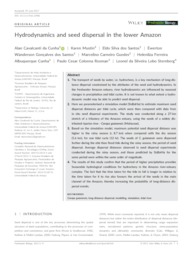Hydrodynamics and seed dispersal in the lower Amazon.
Hydrodynamics and seed dispersal in the lower Amazon.
Author(s): CUNHA, A. C. da; MUSTIN, K.; SANTOS, E. S. dos; SANTOS, E. W. G. dos; GUEDES, M. C.; CUNHA, H. F. A.; ROSMAN, P. C. C.; STERNBERG, L. da S. L.
Summary: The transport of seeds by water, i.e. hydrochory, is a key mechanism of long-distance dispersal constrained by the attributes of the seed and hydrodynamics. In the freshwater Amazon estuary, river hydrodynamics are influenced by seasonal changes in precipitation and tidal cycles. It is not known to what extent a hydrodynamic model may be able to predict seed dispersal. Here we parameterised a simulation model (SisBaHia) to estimate maximum seed dispersal distances per tidal cycle, which were then compared with data from in situ seed dispersal experiments. The study was conducted along a 27-km stretch of a tributary of the Amazon estuary, using the seeds of a widely distributed riparian tree?Carapa guianensis (Meliaceae). Based on the simulation model, maximum potential seed dispersal distance was higher in the rainy season (c. 8.7 km) when compared with the dry season (5.6 km), for one tidal cycle (12 hr). The seeds of C. guianensis were dispersed further during the ebb than flood tide during the rainy season, the period of seed dispersal. Average dispersal distances observed in seed dispersal experiments conducted during the rainy season, and those predicted by SisBaHia for the same period were within the same order of magnitude. The results of this study confirm that the period of higher precipitation provides favourable hydrological conditions for hydrochory in the Amazon river-estuary complex. The fact that the time taken for the tide to fall is longer in relation to the time taken for it to rise also favours the arrival of the seeds in the main channel of the Amazon, thereby increasing the probability of long-distance dispersal events.
Publication year: 2017
Types of publication: Journal article
Unit: Embrapa Amapá
Keywords: Carapa guianensis, Long-distance dispersal, Modelling, Simulation, Tidal river
Observation
Some of Embrapa's publications are published as ePub files. To read them, use or download one of the following free software options to your computer or mobile device. Android: Google Play Books; IOS: iBooks; Windows and Linux: Calibre.
Access other publications
Access the Agricultural Research Database (BDPA) to consult Embrapa's full library collection and records.
Visit Embrapa Bookstore to purchase books and other publications sold by Embrapa.

